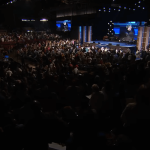Hicks again: He organizes his discussion of the New Covenant fulfillment of the sacrificial system in the phrases “life surrendered,” “life transformed,” and “life shared.” Reconciliation is made on the basis of life surrendered, blood shed, but that’s not the end point of the reconciling sacrifice. This enables him to affirm a sacrificial dimension in the Eucharist while simultaneously criticizing the direction of Catholic eucharistic theology, particularly after Trent. He affirms the 39 Articles that described the Mass as “blasphemy,” but sees the problem as centrally the problem of misunderstanding the character of sacrifice as such.
Because communion became less frequent, the Mass become “concentrated more and more exclusively upon the Cross, until it was distinguished as sacrifice in its relation to the Cross, and as sacrament in what remained of its Communion side.” The sacrificial sequence as a whole was brought into exclusive connection with the death of Jesus, and “it became easy . . . to misread the meaning of ‘burning’ in the Old Testament sacrifices, and to see in it not a transformation through offering, but a destruction in death.”
Further, communion was detached from the rest of the sacrificial sequence. Sacrifice was equated exclusively with death, whereas the biblical notion of sacrifice included table fellowship within it.
He notes that Catholics regularly recognize that the Mass is not a real sacrifice but a “memorial,” and points out that “a memorial is what Zwingli taught: “the paradox, as well of the pathos, of the more extreme developments of the Trent teaching is always this strange oscillation between ‘blasphemy’ and Zwinglianism.” He points this out, he says, not because of harshness or out of desire for controversy, but to highlight the “fatal disability, not of the intentions of the Trent theologians, but of the language in which their times compelled them to speak.”
There is only one solution to the problems of Trent – and the problems of the Reformation (for the Reformation accepted the sacrificial theology of Catholicism, that sacrifice is simply death, and denied that the Eucharist is sacrificial). The solution is to “translate the inadequate and inaccurate language of the Mediaeval theology into the complete and accurate vocabulary of the Bible.” This translation enables us to preserve “the intentions of the Fathers of the Counter-Reformation . . . as well as those of the Fathers of the Reformation itself.”
He concludes: “once, in translating, the true proportions and the accurate technique of sacrifice are recovered, the actions merged in the language of Trent can be dissected out from one another, communion restored to its integral place in the full sacrificial action, the positive teaching of the sacrifice, of the place of the Eucharist in it, of its propitiatory character, can be admitted, the epithets ‘true’ and ‘proper’ can retain their force, and the anathemas may remain indeed on paper, but with no one left to anathematize.”










